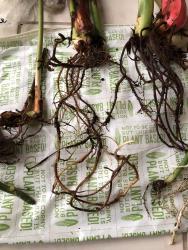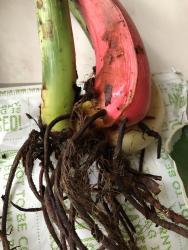The best fungicide to use on stuff like this is CAPTAN. It comes in a canister as a powder, and you can use it as a dip, or make a slurry (it never completely dissolves in water) and soak the plats root system and base before you plant, then use the slurry as a soil drench to water in. It is easy to control because it is a powder, it is not generally used as a spray, so the chance of inhaling it is small compared to other fungicides.
I was schooled about Captan 20= years ago when I was collecting and growing rhizomatous plants like heliconias, etlingeras, calathea, other rare gingers, unusual bananas....unless your live in South Florida and can go a nursery where they sell already containerized plants, the large growing species of these plants are sold by the rhizome....they are dug to order right out of the ground cut apart from the body of the mother plant, all the roots are removed and the rhizome is washed then it is mailed. The roots are removed because they always die anyway, and the plant has to completely grow a new root system. Captan is used before planting to kill any fungus, because trying to reroot these rhizomes can sometimes end with them rotting before they root.
The B vitamins are commonly used here as Superthrive. Some people swear by SUperthrive, some people say its crap.




